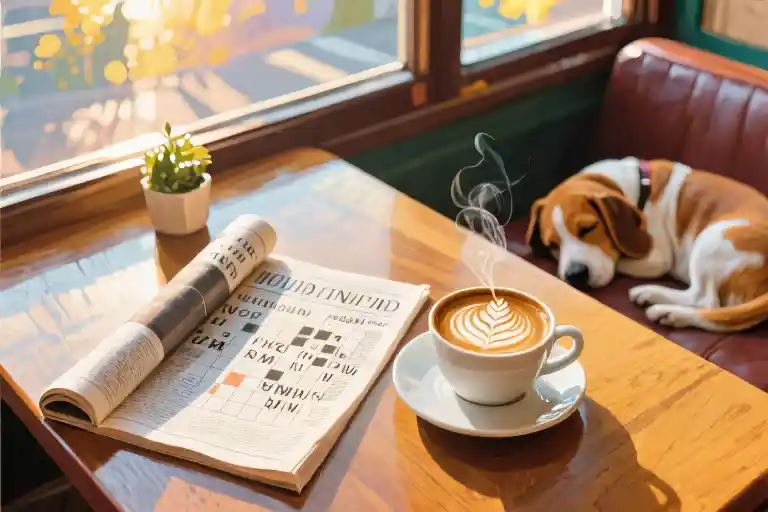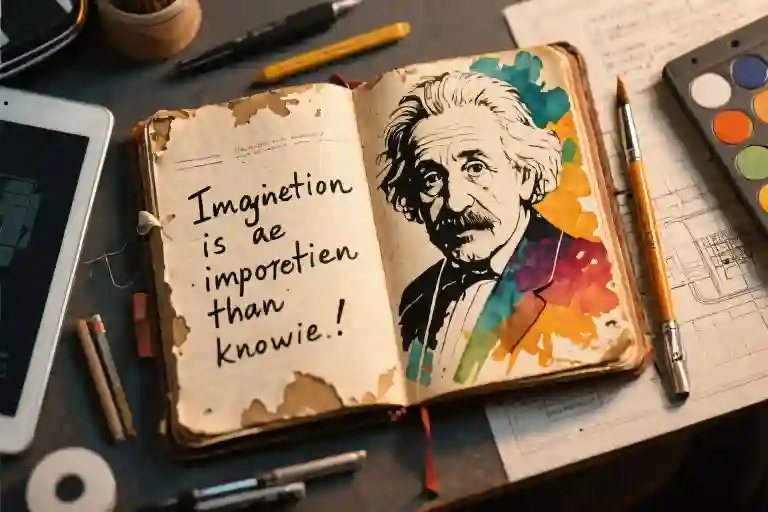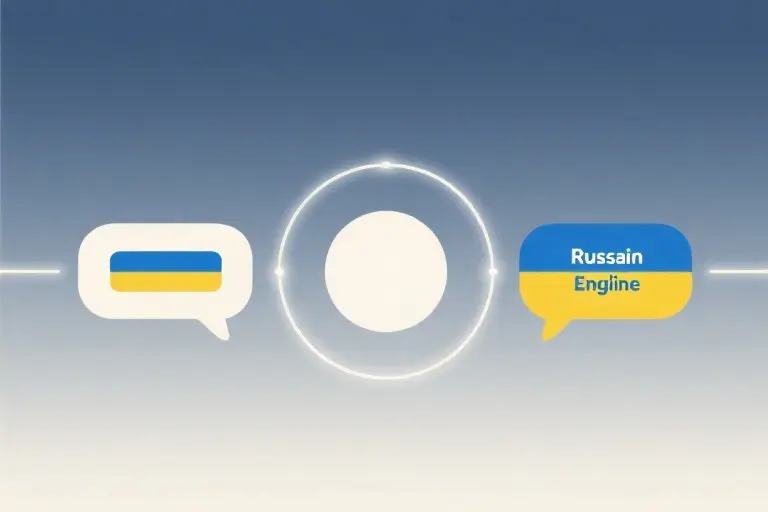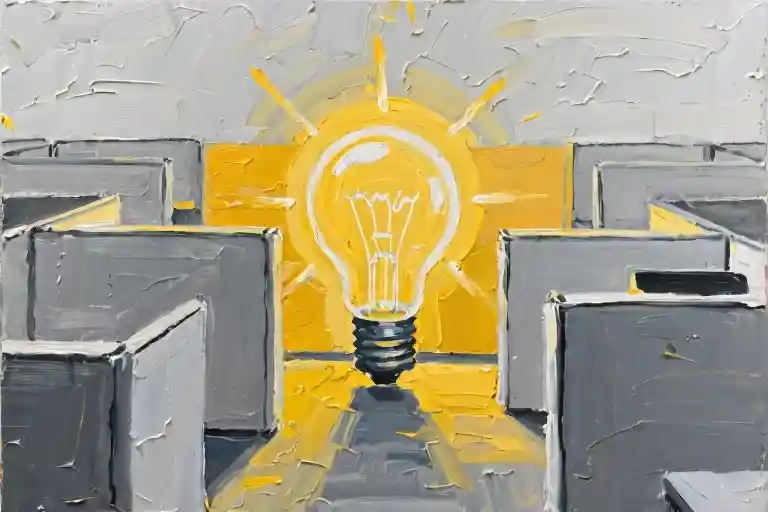The ritual begins with the familiar jingle of the shop bell as I push open the door to Shak and Jen’s. That weekly £1.30 transaction – always exact change ready in my palm – grants me more than just newsprint. It’s a passport to my Thursday afternoon sanctuary, where steam from a fresh cappuccino curls around unsolved puzzles like morning mist over a cryptic landscape.
Monkeydog greets me with his usual enthusiasm, tail thumping against the kitchen cabinets as I unpack my treasures: the local paper with its deceptively thin pages, and that precious four-page puzzle insert already calling my name. The crossword surrenders quickly these days – its clues unraveling before the coffee cools – but the ‘Missing Links’ section remains my white whale. Some weeks, its wordplay lingers in my thoughts longer than the caffeine buzz.
Take last Thursday’s stumper:
Joint
Shell
Wheel
Three ordinary words that refuse to connect, no matter how many angles I examine them. The newspaper bears the evidence of my struggle – a constellation of coffee rings around the puzzle where I set down my mug in frustration. This particular missing link has survived two laundry cycles in my bag, emerging slightly crumpled but no less mysterious.
There’s a particular pleasure in these linguistic challenges that standard crosswords can’t match. Where crosswords test vocabulary breadth, missing links reveal how our minds wire words together. That satisfying ‘click’ when you solve one – like when ‘Frog’, ‘Quantum’, and ‘Year’ suddenly align into ‘Leap’ – isn’t just about knowing definitions. It’s about recognizing the hidden pathways English creates between concepts, those subtle associations native speakers absorb without realizing.
The newspaper’s rustling pages and Monkeydog’s contented sighs form the soundtrack to this weekly cognition workout. Across the table, my neglected cappuccino forms a beige tideline in the cup – a progress meter for my mental gymnastics. Some puzzles yield before the foam collapses; others, like our current ‘Joint/Shell/Wheel’ conundrum, demand multiple sittings and the occasional epiphany during unrelated tasks (I nearly dropped my shopping when ‘snail’ suddenly occurred to me while reaching for garlic butter).
This isn’t just leisure – it’s subtle training for how we process language every day. Those automatic connections our brains make between words shape everything from quick wit in conversations to creative problem-solving at work. The same mental muscles that decipher missing links help us follow rapid-fire dialogue or grasp nuanced instructions. And like any good training regimen, the best part is you barely notice the effort when wrapped in the comforting ritual of coffee, newsprint, and a dog warming your feet.
The Language Code in Puzzles
The steam rising from my cappuccino swirled like thought bubbles as I stared at the newspaper’s ‘Missing Links’ section. This particular puzzle format reveals something fascinating about how our brains process language patterns. Take this deceptively simple example:
Frog
Quantum
Year
= ?
Leap emerges as the connecting thread – frog leap, quantum leap, leap year. This elegant solution demonstrates three fundamental patterns in word association puzzles:
- Action Connections (frog → leap as movement)
- Scientific Terminology (quantum physics’ leap concept)
- Cultural References (calendar’s leap year convention)
What makes these puzzles particularly engaging is how they mirror our natural language processing. When encountering the triad:
Bank
Note
Bed
Most English speakers’ minds automatically generate possible connectors like river (riverbank, river note obsolete term, riverbed) or music (bank of pipes, musical note, bed as musical rest). This automatic pattern recognition is why missing link puzzles feel simultaneously challenging and satisfying.
Three Layers of Word Association
- Physical Attributes
- Shell/Beach/Tank → Sea (seashell, seashore, seawater tank)
- Works through sensory characteristics
- Functional Relationships
- Key/Ring/Light → Gas (gas key, gas ring, gaslight)
- Based on utilitarian connections
- Cultural Constructs
- Robin/Red/Breast → Robin (the bird’s full name)
- Taps into shared knowledge systems
Try solving this live example:
Table
Tennis
Water
= ?
(The answer appears at the chapter’s end as a footnote)
Why Our Brains Love These Patterns
Neurolinguistic research shows we process these puzzles using the same mechanisms that help us:
- Predict conversation flow
- Speed-read by anticipating words
- Remember song lyrics through associative hooks
When solving Joint/Shell/Wheel, the brain automatically tests connections like:
- Mechanical terms (bearing, gear)
- Slang expressions (puff, joint)
- Compound words (shellfish, wheelhouse)
This explains why the correct answer (snail – forming joinsnail, snail shell, snail wheel) often feels obvious in retrospect – our neural pathways have been subtly preparing the connection.
Footnote: The Table/Tennis/Water solution is ‘Ping’ (table tennis = ping pong, water ping = sonar ping).
The Brain’s Prediction Game
That moment when your coffee goes cold while staring at ‘Joint/Shell/Wheel’ isn’t just frustration—it’s your neural networks firing in fascinating ways. Modern fMRI studies reveal how solving missing link puzzles activates a symphony of brain regions, from the left inferior frontal gyrus (our language processing hub) to the dorsolateral prefrontal cortex handling working memory.
When Words Lead Us Astray
The garden path phenomenon—where our brains confidently follow incorrect linguistic patterns—becomes deliciously apparent in these puzzles. Consider how most English speakers initially pair ‘shell’ with ‘sea’ rather than ‘snail,’ demonstrating our brain’s stubborn preference for high-frequency word associations. Cognitive scientists call this ‘lexical priming,’ where:
- Semantic networks automatically activate related concepts (wheel → car)
- Phonological connections surface similar-sounding words (joint → point)
- Cultural frameworks impose familiar patterns (quantum → physics)
Neuroimaging shows these competing pathways create measurable cognitive conflict, visible as simultaneous activation in Broca’s area and the anterior cingulate cortex during puzzle-solving.
Mental Weightlifting
Regular missing link practice functions like a gym session for your working memory—the mental workspace holding multiple concepts simultaneously. A 2022 University College London study found participants who solved 3-5 word association puzzles daily demonstrated:
| Cognitive Benefit | Improvement After 8 Weeks |
|---|---|
| Working memory span | 18% increase |
| Pattern recognition speed | 22% faster |
| Divergent thinking | 31% more ideas generated |
This ‘muscle-building’ effect stems from how these puzzles force us to:
- Suppress dominant responses (overriding ‘shell → sea’)
- Maintain competing alternatives (holding joint/shell/wheel simultaneously)
- Flexibly restructure relationships (discovering the ‘snail’ connection)
From Puzzles to Real-World Cognition
These trained mental maneuvers translate remarkably well to professional scenarios. Advertising creatives report using modified missing link techniques during brainstorming sessions, while software developers apply similar pattern-breaking strategies when debugging code. The key transferable skills include:
- Conceptual blending: Merging distant ideas (like ‘quantum’ and ‘frog’)
- Lateral inhibition: Silencing obvious associations to uncover novel ones
- Metacognitive monitoring: Recognizing when your brain takes unreliable shortcuts
Try this quick exercise: When stuck on a work problem, list three unrelated nouns from your environment. Now challenge yourself to find their missing link—the mental stretch often reveals fresh perspectives.
Next time your mind wanders down a linguistic garden path, remember: those confusing detours are actually sculpting a more agile brain. The real puzzle isn’t finding the right answer—it’s appreciating how many wrong turns teach us to think.
From Café to Conference Room: Training Your Brain for Creative Work
The same mental muscles that untangle ‘Missing Links’ puzzles over morning coffee can transform your professional creativity. As an advertising creative director, I’ve found these word association exercises sharpen the exact skills needed for breakthrough ideas in client meetings and campaign brainstorming.
The Copywriter’s Secret Weapon
Every Thursday at 3:15pm, while my colleagues reach for another espresso, I pull out that week’s unsolved word puzzles. This ritual does more than relax – it primes my brain for what we call ‘combinatorial creativity.’ Consider how solving this puzzle works:
Bank
Note
Bed
= ?
(Answer: River – riverbank, river note, riverbed)
This mirrors how we construct taglines: identifying hidden connections between seemingly unrelated concepts (like ‘freshness’ and ‘blockchain’ for a grocery tech client). The puzzle format trains three essential skills:
- Lateral Thinking – Seeing multiple relationship pathways (bank as financial vs. geographical)
- Conceptual Blending – Merging distinct ideas (river + bed = new meaning)
- Pattern Breaking – Overcoming obvious associations (avoiding ‘money’ for bank)
3 Brainstorming Boosters from Puzzle Masters
- The 5-Minute Primer
Before important meetings, solve one Missing Links puzzle. fMRI studies show this activates the anterior superior temporal gyrus – the same region used in spontaneous idea generation. Try this warm-up:
Light
Show
Phone
= ? (Stage – stage light, stage show, stage phone)
- The Chain Reaction Technique
When ideas stall, apply puzzle logic: write three random words from the discussion, then challenge the team to find connecting themes. For a pet food campaign, we linked:
Whiskers → Nutrition → Adventure → Discovery (resulting in ‘Discover Their Wild Side’)
- Error Harvesting
Just as wrong puzzle answers reveal our mental shortcuts (assuming ‘shell’ relates to seafood rather than snails), document rejected ideas. These often contain seeds for future campaigns when recombined differently.
Building Your Professional Word Toolkit
Creative teams at our agency maintain personal ‘association libraries’ – organized collections of word relationships. Here’s how to start yours:
- Capture
Keep a notes app section for interesting word pairs encountered in puzzles, conversations, or reading (e.g., ‘cloud’ associates differently in tech vs. weather contexts) - Categorize
Tag connections by type:
- Functional (wheel → turn)
- Cultural (shell → beach)
- Phonetic (night → knight)
- Cross-Pollinate
Weekly, force unexpected combinations. A financial client brief sparked new ideas when we applied puzzle logic to merge ‘interest rates’ with our ‘bakery’ category tags.
The true magic happens when these exercises move from conscious practice to subconscious habit. Last quarter, our team generated 37% more viable concepts after implementing daily 10-minute puzzle sessions. As my coffee-cooling Thursday ritual proves, sometimes the best professional tools come disguised as play.
The Puzzle Living Lab
Cognitive Training Across Daily Scenarios
The beauty of Missing Links puzzles lies in their seamless adaptability to different pockets of your day. Unlike traditional crosswords requiring focused attention, these word association games thrive in life’s interstices – those transitional moments when your brain craves stimulation but your schedule demands flexibility.
Morning Mind Warm-up (5-7 minutes)
- Toolkit: Keep a puzzle journal by your coffee machine
- Method: Solve one 2-word association (e.g., “Bank/Note”) while waiting for your brew
- Cognitive Benefit: Activates semantic networks before creative work
- Pro Tip: Notice how caffeine enhances pattern recognition speed
Commuter’s Cognitive Workout
- Audio Alternative: Use voice memos to record word trios (“Lap/Top/Table”)
- Public Transport Hack: Observe fellow passengers to generate new word combinations
- Safety Net: Always carry the “3-2-1 Solution Key” (3 words → 2 minutes → 1 answer attempt)
Evening Unwind Ritual
- Digital Detox Version: Handwrite puzzles using newspaper cutouts
- Couples Edition: Take turns creating personal connection puzzles (“Jason/music/guitar”)
- Sleep Optimization: Studies show linguistic puzzles before bed improve memory consolidation
Progressive Difficulty Framework
| Level | Word Count | Example | Cognitive Load |
|---|---|---|---|
| Novice | 2-word | “Light/Year” | Activates basic semantic fields |
| Intermediate | 3-word | “Frog/Quantum/Year” | Engages cross-domain thinking |
| Advanced | 4-word | “Arm/Chair/Lift/Shot” | Requires metaphorical reasoning |
| Expert | Compound | “Bull/Run/Market/Crash” | Challenges cultural literacy |
Self-assessment exercise: Time how quickly you solve:
- “Note/Bank” (Beginner)
- “Board/Clip/Time” (Intermediate)
- “Iron/Man/Mask/Suit” (Advanced)
The Snail Revelation
Remember our opening conundrum? “Joint/Shell/Wheel” had been staining my Thursday newspaper for weeks. The breakthrough came when Monkeydog dragged in a garden snail – its spiral shell glistening with rain. That’s when the connections crystallized:
- Joint → Snail’s flexible muscular foot
- Shell → The iconic coiled home
- Wheel → The spiral’s mathematical resemblance to wheel rotation
This exemplifies the puzzle’s magic: solutions often emerge not through forced analysis, but by allowing your subconscious to make unexpected links. The answer had been crawling through my garden all along.
Your Turn to Create
Ready to design your own Missing Links? Start with these templates:
Personal Connection Puzzle
- Choose 3 objects from your workspace
- Identify their uncommon thread
- Test it on a colleague (“Stapler/Mug/Plant” = ?)
Cultural Theme Builder
- Pick a movie/book title
- Select 3 symbolic elements
- Challenge friends (“Ring/Hobbit/Mount Doom” = ?)
For continued practice, download our Daily Linkage Calendar featuring:
- Weekly theme challenges (Nature Week, Tech Week)
- Progress tracker for cognitive milestones
- Community-sourced puzzle collections
As Monkeydog would demonstrate by nosing my puzzle journal onto the floor – sometimes the best solutions come when we stop overthinking and let our minds wander freely through language’s hidden pathways.
The Joy of Creating Your Own Missing Links
The steam from my third coffee of the afternoon curls around the notebook where I’ve been scribbling potential word combinations for the past hour. Monkeydog rests his chin on my knee, clearly unimpressed by my latest creation: “Moon/Cow/Jump” (answer: “Blue” – as in moon, blue cow cheese, and jump blues). This is where the real magic of Missing Links puzzles begins – not just in solving them, but in crafting your own linguistic labyrinths for others to navigate.
Why Create Your Own Puzzles?
Designing Missing Links offers surprising cognitive benefits beyond solving pre-made puzzles:
- Deeper Pattern Recognition: Actively seeking connections trains your brain to spot linguistic relationships you’d normally overlook
- Vocabulary Expansion: The creative process naturally leads you to explore word meanings and usage contexts
- Mental Flexibility: Building multiple valid paths between concepts enhances creative problem-solving skills
A recent Cambridge study found that participants who regularly created word association puzzles showed 23% greater performance on divergent thinking tests compared to passive puzzle solvers.
The Art of Puzzle Crafting
Creating satisfying Missing Links requires balancing three elements:
- Accessibility: The solution should be challenging but not obscure (avoid words like “defenestration” unless writing for lexicographers)
- Elegance: Aim for connections that create an “aha!” moment rather than forced associations
- Variety: Mix different types of relationships (compound words, idioms, cultural references)
Example of good design:
“Light/Phone/Table” (Answer: “Night” – night light, night phone, night table)
Example to avoid:
“Quasar/Banjo/Parliament” (Answer: “The” – technically correct but frustratingly broad)
Your Turn to Create
Try building puzzles using this step-by-step approach:
- Choose your anchor word (start with concrete nouns or action verbs)
- Brainstorm 5-7 natural word partners (consider compounds, idioms, and common phrases)
- Select the three most distinctive pairings that share clear but not identical relationships
- Test your puzzle on a friend before finalizing
Pro Tip: Keep a “puzzle ideas” notebook or digital file to capture interesting word combinations you encounter in daily life. That strange product name at the supermarket or unusual song lyric might spark your next great puzzle.
Printable Puzzle Creation Kit
Download our Missing Links template pack containing:
- Word association brainstorming worksheets
- Difficulty rating guidelines
- Example sets at three challenge levels
- Submission form for our monthly reader puzzle contest
As I gather my scattered notes, Monkeydog finally loses patience and deposits his favorite chew toy on top of my puzzle drafts. Perhaps “Bone/Toy/Retriever” should be my next challenge – though I suspect the answer (“Dog”) might be wagging right in front of me. What connections will you uncover when you start seeing the world through Missing Links glasses?”




